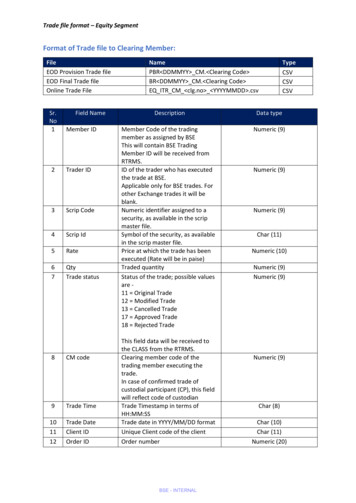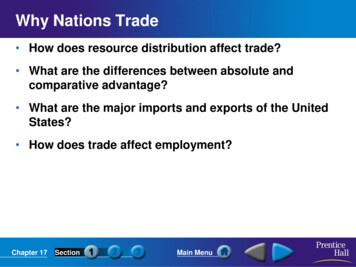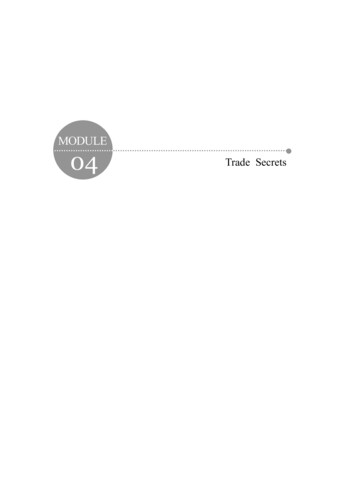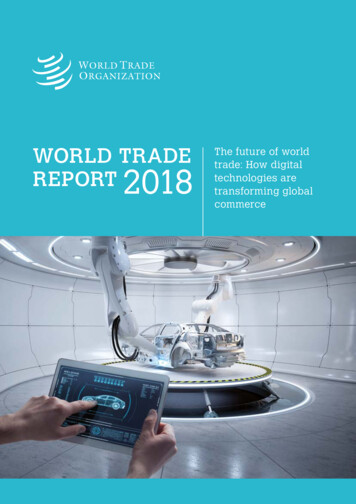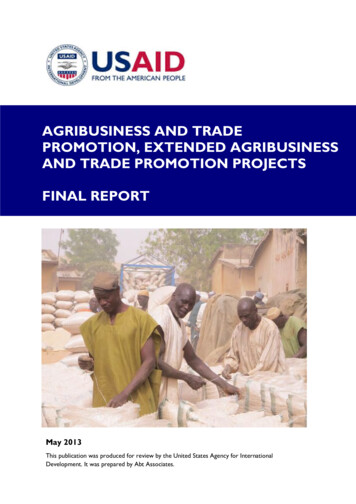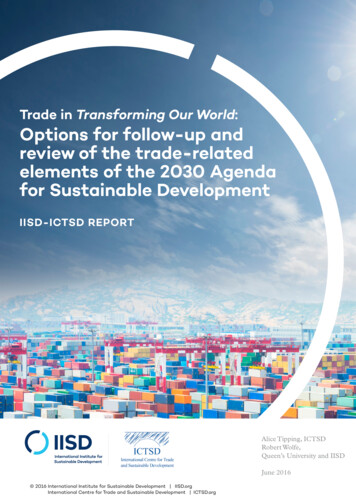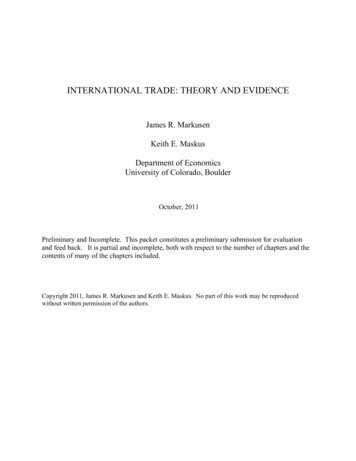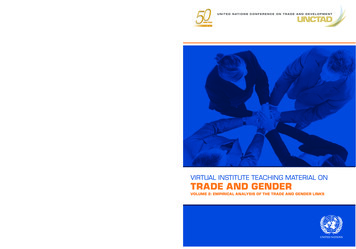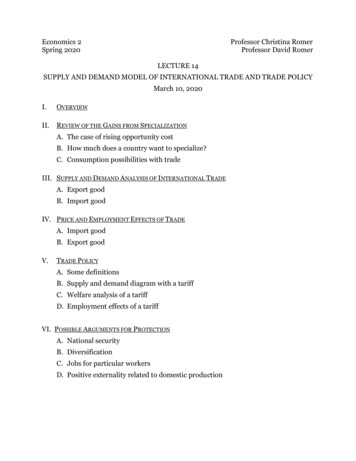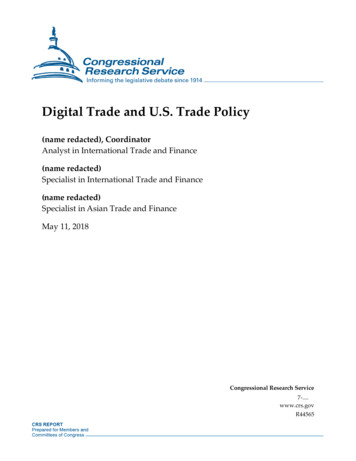
Transcription
Digital Trade and U.S. Trade Policy(name redacted), CoordinatorAnalyst in International Trade and Finance(name redacted)Specialist in International Trade and Finance(name redacted)Specialist in Asian Trade and FinanceMay 11, 2018Congressional Research Service7-.www.crs.govR44565
Digital Trade and U.S. Trade PolicySummaryAs the global Internet develops and evolves, digital trade has become more prominent on theglobal trade and economic policy agenda. The economic impact of the Internet was estimated tobe 4.2 trillion in 2016, making it the equivalent of the fifth-largest national economy. Growingfaster than international trade or financial flows, the volume of global data flows grew 45-foldfrom 2005 to 2014.Congress has an important role to play in shaping global digital trade policy, from oversight ofagencies charged with regulating cross-border data flows to shaping and considering legislationimplementing new trade rules and disciplines through trade negotiations. Congress also workswith the executive branch to identify the right balance between digital trade and other policyobjectives, including privacy and national security.Digital trade includes end-products like downloaded movies and also products and services thatrely on or facilitate digital trade such as productivity-enhancing tools like cloud data storage andemail. In 2016, U.S. exports of information and communications technology-enabled servicesexports (excluding digital goods) were 404 billion.1 Digital trade is growing on a global basis;worldwide e-commerce was 27.7 trillion in 2016, up from 19.3 trillion in 2012.2The increase in digital trade raises new challenges in U.S. trade policy, including how to bestaddress new and emerging trade barriers. As with traditional trade barriers, digital tradeconstraints can be classified as tariff or nontariff barriers. In addition to high tariffs, barriers todigital trade may include localization requirements, cross border data flow limitations, intellectualproperty rights (IPR) infringement, forced technology transfer, web filtering, and cybercrimeexposure or state-directed theft of trade secrets. China’s policies, in particular, such as those onInternet sovereignty and cybersecurity, pose challenges for U.S. companies.Digital trade issues often overlap and cut across policy areas, such as IPR and national security;this raises questions for Congress as it weighs different policy objectives. The Organization forEconomic Cooperation and Development (OECD) points out three potentially conflicting policygoals in the Internet economy: (1) enabling the Internet; (2) boosting or preserving competitionwithin and outside the Internet; and (3) protecting privacy and consumers, more generally.While no multilateral agreement on digital trade exists in the World Trade Organization (WTO),other WTO agreements cover some aspects of digital trade. Recent bilateral and plurilateralagreements have begun to address digital trade rules and barriers more explicitly. For example,the renegotiation of the North American Free Trade Agreement (NAFTA) and the potentialplurilateral Trade in Services Agreement (TiSA) could address digital trade barriers to varyingdegrees. Digital trade is also being discussed in a variety of international forums, providing theUnited States with multiple opportunities to engage in and shape global norms.With workers in the high-tech sector in every U.S. state and congressional district, and over twothirds of U.S. jobs requiring digital skills, Congress has an interest in ensuring and developing theglobal rules and norms of the Internet economy in line with U.S. laws and norms, and inestablishing a U.S. trade policy on digital trade that advances U.S. interests.1Bureau of Economic Analysis (BEA),https://www.bea.gov/iTable/iTable.cfm?ReqID 62&step 1#reqid 62&step 9&isuri 1&6210 4.2U.S. International Trade Commission, Global Digital Trade 1: Market Opportunities and Key Foreign TradeRestrictions, Publication Number: 4716, Investigation Number: 332-561, August 2017, 6.pdf.Congressional Research Service
Digital Trade and U.S. Trade PolicyContentsIntroduction . 1Role of Digital Trade in the U.S. and Global Economy . 2Economic Impact of Digital Trade . 5Digitization Challenges . 8Digital Trade Policy and Barriers . 10Tariff Barriers . 11Nontariff Barriers . 12Localization Requirements . 13Intellectual Property Rights (IPR) Infringement . 15National Standards and Burdensome Conformity Assessment . 17Filtering, Blocking, and Net Neutrality . 17Cybersecurity Risks . 18U.S. Digital Trade with Key Trading Partners. 19European Union . 19EU-U.S. Privacy Shield . 22General Data Protection Regulation (GDPR) . 22Digital Single Market (DSM) . 23China . 24Internet Governance and the Concept of “Internet Sovereignty” . 25IP Theft . 26Digital Trade Provisions in Trade Agreements . 29WTO Provisions . 30General Agreement on Trade in Services (GATS) . 30Declaration on Global Electronic Commerce . 30Information Technology Agreement (ITA) . 31Agreement on Trade-Related Aspects of Intellectual Property Rights (TRIPS) . 32World Intellectual Property Organization (WIPO) Internet Treaties . 32U.S. Bilateral and Plurilateral Agreements . 33Existing U.S. Free Trade Agreements (FTAs) . 33Trans-Pacific Partnership (TPP) Agreement . 34North American Free Trade Agreement (NAFTA) . 35Trade in Services Agreement (TiSA) Negotiations . 36Other International Forums for Digital Trade. 36Issues for Congress . 38FiguresFigure 1. Growth in Global Trade, Finance, and Data Flows . 2Figure 2. A Typical Day in the Life of the Internet . 3Figure 3. What is Digital Trade? . 5Figure 4. Select U.S.-EU Cross-Border E-Commerce Purchases . 20Figure 5. Digitally Deliverable Service Exports 2017 . 21Figure 6. Digitally Deliverable Services Incorporated into Global Value Chains . 21Figure 7. The U.S. and China Digital Trade Markets . 24Congressional Research Service
Digital Trade and U.S. Trade PolicyFigure 8. U.S.-China High-Level Joint Dialogues on Cybercrime and Related Issues . 27ContactsAuthor Contact Information . 39Acknowledgments . 39Congressional Research Service
Digital Trade and U.S. Trade PolicyIntroductionThe Internet-driven digital revolution is causing fundamental change to the U.S. and globaleconomy, leading not only to new modes of communication and information-sharing, businessmodels, and sources of job growth, but also to new policy challenges. Data and data flows formthe foundation for innovation and engine of economic growth. Almost two-thirds of jobs createdin the United States since 2010, required medium or advanced levels of digital skills.3 As digitalinformation increases in importance in the U.S. economy, issues related to digital trade havebecome of growing interest to Congress.While there is no globally accepted definition of digital trade, the U.S. International TradeCommission (USITC) broadly defines digital trade as:The delivery of products and services over the Internet by firms in any industry sector, and ofassociated products such as smartphones and Internet-connected sensors. While it includesprovision of e-commerce platforms and related services, it excludes the value of sales ofphysical goods ordered online, as well as physical goods that have a digital counterpart (suchas books, movies, music, and software sold on CDs or DVDs).4Digital trade not only includes end-products like downloaded movies and video games, but alsothe means to enhance the productivity and overall competitiveness of an economy, such asinformation streams needed by manufacturers to manage global operations; communicationchannels (email and voice over Internet protocol (VoIP)); and financial data and transactions foronline purchases or electronic banking.The rules governing digital trade are evolving as governments across the globe experiment withdifferent approaches and consider diverse policy priorities and objectives. Barriers to digitaltrade, such as infringement of intellectual property rights (IPR) or protective industrial policies,often overlap and cut across sectors. In some cases, policymakers may struggle to balance digitaltrade objectives with other legitimate policy issues related to national security and privacy.Digital trade policy issues have been in the spotlight recently, due in part to the rise of new tradebarriers, heightened concerns over data privacy, and an increasing number of cybertheft incidentsthat have affected U.S. consumers and companies. These concerns may raise the general U.S.interest in promoting, or restricting, cross-border data flows and in enforcing compliance withexisting rules. Congress has an interest in ensuring the global rules and norms of the Interneteconomy are in line with U.S. laws and norms.Trade negotiators continue to explore ways to address evolving digital issues in trade agreements,including in the ongoing renegotiation of the North American Free Trade Agreement (NAFTA).Congress has an important role in shaping digital trade policy, including oversight of agenciescharged with regulating cross-border data flows, as part of trade negotiations, and in workingwith the executive branch to identify the right balance between digital trade and other policyobjectives.This report discusses the role of digital trade in the U.S. economy, barriers to digital trade, digitaltrade agreement provisions, and other selected policy issues.3Penny Pritzker and John Engler, Director Edward Alden, The Work Ahead: Machines, Skills, and U.S. Leadership inthe Twenty-First Century, Independent Task Force Report, The Council for Foreign Relations, April 2018.4U.S. International Trade Commission, Global Digital Trade 1: Market Opportunities and Key Foreign TradeRestrictions, August 2017, p.33, .Congressional Research Service1
Digital Trade and U.S. Trade PolicyRole of Digital Trade in the U.S. andGlobal EconomyThe Internet not only has become a facilitator of existing international trade in goods andservices, but is itself a platform for new digitally originated services. The Internet is enablingtechnological shifts that are transforming businesses. According to one estimate, the volume ofglobal data flows is growing faster than trade or financial flows (see Figure 1). Some analysesindicate that global flows of goods, services, finance, and people increased gross domesticproduct (GDP) by at least 10% in the past decade, adding US 8 trillion by 2015.5Figure 1. Growth in Global Trade, Finance, and Data FlowsSource: McKinsey Global Institute, Digital Globalization: The New Era of Global Flows, March 2016.The increase in digital trade parallels the growth in Internet usage globally. According to theUnited Nations International Telecommunication Union (ITU), 48% of people globally use theInternet.6 The Organization for Economic Cooperation and Development (OECD) reports that in2014, on average, 95% of enterprises in OECD countries had a broadband connection and 76%had a website or homepage.7 In the United States, 92% of the population uses the Internet,according to one estimate.8 While 75% of U.S. households use wired Internet access, anincreasing number are relying on mobile Internet access, with 72% of U.S. adults owning asmartphone, as the Internet is integrated into people’s everyday lives.9 While the percentage ofAmerican consumers relying on a desktop or laptop at home is declining, they increasingly areturning to an array of devices from smartphones to wearable devices for Internet access.10 Each5Jacques Bughin and Susan Lund, "The ascendancy of international data flows," VOX, January 9, 2017.ITU, ICT Facts and Figures 2017, 2017, /default.aspx.7The United States was not included in the study. OECD. (2015), “Executive summary,” OECD Digital EconomyOutlook 2015, pp. 2-3, OECD Publishing, Paris. DOI: rnet Association, Measuring the U.S. Internet Sector, 2015, rnet-Sector-12-10-15.pdf.9U.S. International Trade Commission, Global Digital Trade 1: Market Opportunities and Key Foreign TradeRestrictions, Publication Number: 4716, Investigation Number: 332-561, August 2017, 4716.pdf.10Giulia McHenry, Evolving Technologies Change the Nature of Internet Use, National Telecommunications &Information Administration blog, April 19, 2016.6Congressional Research Service2
Digital Trade and U.S. Trade Policyday, companies and individuals depend on the Internet to communicate and transmit data viavarious media and channels that continue to expand with new innovations (see Figure 2).Cross-border data and communication flows are part of digital trade; they also facilitate trade andthe flows of goods, services, people, and finance, which together are the drivers of globalizationand interconnectedness. One estimate shows that although cross-border bandwidth grew by 45times from 2005 through 2015, it may grow by nine times more by 2021.11 The highest levelsreportedly are those flows between the United States and Western Europe, Latin America, andChina. Efforts to impede cross-border data flows impact digital trade which could decreaseefficiency and other potential benefits.Figure 2. A Typical Day in the Life of the InternetSource: The World Bank Group, World Development Report 2016: Digital Dividends, 2016, p. Powering all these connections and data flows are underlying information and communicationtechnologies (ICT).12 ICT spending is a large and growing component of the internationaleconomy and essential to digital trade and innovation. For example, software contributed morethan 1.14 trillion to the U.S. value-added GDP in 2016, an increase of 6.4% over 2014, and theU.S. software industry accounted for 2.9 million jobs directly in 2016.13According to the OECD, world trade in ICT physical goods grew 12% from 2008 through 2015.In the United States, growth in ICT manufacturing output was approximately 5% per year as of2015-2016.14 The broader digital sector (defined as online platforms, platform-enabled services,11Jacques Bughin and Susan Lund, "The ascendancy of international data flows," VOX, January 9, 2017.ICT is an umbrella term that includes any communication device or application, including radio, television, cellularphones, computer and network hardware and software, satellite systems, and associated services and applications.13EIU estimates, “The Growing 1 Trillion Economic Impact of Software,” software.org.14OECD (2017), OECD Digital Economy Outlook 2017, OECD Publishing, Paris, p. 120-124.(continued.)12Congressional Research Service3
Digital Trade and U.S. Trade Policyand suppliers of ICT goods and services) accounted for approximately 1% in 2015.15Semiconductors, a key component in many electronic devices, are a top U.S. ICT export, and,global sales of semiconductors grew to 412.2 billion in 2017, an increase of 21.6% over theprior year.16 Given the importance of semiconductors to the digital economy, countries such asChina are seeking to grow their own semiconductor industry to lessen their dependence on U.S.exports.ICT services are outpacing the growth of international trade in ICT goods. The OECD estimatesthat ICT services trade increased 40% from 2010 to 2016. A U.S. competitive strength, the UnitedStates is the fourth-largest OECD exporter of ICT services, after Ireland, India, and theNetherlands.17 ICT services include telecommunications and computer services, as well ascharges for the use of intellectual property (e.g., licenses and rights). ICT-enabled services arethose services with outputs delivered remotely over ICT networks, such as online banking oreducation. ICT services can augment the productivity and competitiveness of goods and services.In 2016, exports of ICT services accounted for 66 billion of U.S. exports while services exportsthat could be potentially ICT-enabled were another 404 billion, demonstrating the impact of theInternet and digital /9789264276284-en.15OECD, Measuring the Digital Economy, OECD Staff Report, February 2018.16Semiconductor Industry Association, “Annual Semiconductor Sales Increase 21.6 Percent, Top 400 Billion for FirstTime,” February 5, 2018.17OECD (2017), OECD Digital Economy Outlook 2017, OECD Publishing, Paris.http://dx.doi.org/10.1787/9789264276284-en. .18Bureau of Economic Analysis (BEA),https://www.bea.gov/iTable/iTable.cfm?ReqID 62&step 1#reqid 62&step 9&isuri 1&6210 4.Congressional Research Service4
Digital Trade and U.S. Trade PolicyFigure 3. What is Digital Trade?Examples of international digital tradeSource: CRS.Note: The above graphic is illustrative only and is not based on a real business or reflective of all aspects ofdigital trade.Economic Impact of Digital TradeAs the Internet and technology continue to develop rapidly, increasing digitization affects financeand data flows, as well as the movement of goods and people. Beyond simple communication,digital technologies can affect global trade flows in multiple ways and have broad economicimpact (see Figure 3). First, digital technology enables the creation of new goods and services,such as e-books, online education or banking services. Digital technologies may also add value byraising productivity and/or lowering the costs and barriers related to flows of traditional goodsand services. For example, companies may rely on radio-frequency identification (RFID) tags forCongressional Research Service5
Digital Trade and U.S. Trade Policysupply chain tracking, 3-D printing based on data files, or devices or objects connected via theInternet of Things (see text box). In addition, digital platforms serve as intermediaries formultiple forms of digital trade, including e-commerce, social media, and cloud computing. Inthese ways, digitization pervades every industry sector, creating challenges and opportunities forestablished and new players.According to USITC estimates, digital trade, including both U.S. domestic commerce andinternational trade, increased U.S. GDP by an estimated 3.4%-4.8% ( 517.1- 710.7 billion) in2011. In addition, U.S. real wages increased by an estimated 4.5%-5.0% and total U.S.employment was higher by 2.4 million full-time equivalents (FTEs) as a result of digital trade.19Some estimates show that, without the Internet, the costs of U.S. imports and exports would havebeen an average of 26% higher, potentially lowering profits or increasing end prices.20Looking at digital trade in an international context, approximately 12% of physical goods aretraded via international e-commerce.21 Global e-commerce grew from 19.3 trillion in 2012 to 27.7 trillion in 2016, of which 86% was business-to-business (B2B).22 One study found that overhalf of Internet users globally purchased online in 2015.23These estimates do not quantify the additional benefits of digitization upon business efficiencyand productivity, or of increased customer and market access, which enable greater volumes ofinternational trade for firms in all sectors of the economy. One study coined the term “digitalspillovers” to fully capture the digital economy and estimated the global digital economy,including such spillovers, was 11.5 trillion in 2016, or 15.5% of global GDP.24 Their analysisshowed that the long-term return on investment (ROI) for digital technologies is 6.7 times that ofnon-digital investments.25Blockchain is one emerging software technology some companies are using to increase efficiencyand transparency and lower supply chain costs that depends on open data flows of digital trade.26For example, in an effort to streamline processes, save costs, and improve public healthoutcomes, Walmart and IBM are piloting a blockchain platform to increase transparency of globalsupply chains and improve traceability for certain imported food products.27 The initiative aims toexpand to include several multinational food suppliers, farmers, and retailers and depends onconnections via the Internet of Things and open international data flows. With increased19U.S. International Trade Commission, Digital Trade in the U.S. and Global Economies, Part 2, Publication No:4485, Investigation No: 332-540, p. 13, August 2014, .20U.S. International Trade Commission, Digital Trade in the U.S. and Global Economies, Part 2, Publication No:4485, Investigation No: 332-540, August 2014, p. 65. .21Jacques Bughin and Susan Lund, "The ascendancy of international data flows," VOX, January 9, 2017.22U.S. International Trade Commission, Global Digital Trade 1: Market Opportunities and Key Foreign TradeRestrictions, Publication Number: 4716, Investigation Number: 332-561, August 2017, 6.pdf.23eMarketer,”Worldwide Retail E-commerce Sales: eMarketer’s Updated Estimates and Forecast Through 2019,”https://www.emarketer.com/public media/docs/eMarketer eTailWest2016 Worldwide ECommerce Report.pdf.24Huawei Technologies and Oxford Economics, Digital Spillover, over/files/gci digital spillover.pdf.25Ibid.26For more on blockchain, see CRS Report R45116, Blockchain: Background and Policy Issues, by (name redacted).27Roger Aitken, “IBM & Walmart Launching Blockchain Food Safety Alliance In China With Fortune 500's JD.com,”Forbes, December 14, 2017.Congressional Research Service6
Digital Trade and U.S. Trade Policyapplications, the Internet of Things may have a global economic impact of as much as 11.1trillion per year, according to one study.28What Is the Internet of Things and Blockchain?Internet of Thingsencompass(es) all devices and objects whose state can be read or altered via the internet, with or without theactive involvement of individual. The internet of things consists of a series of components of equal importance– machine-to-machine communication, cloud computing, big data analysis, and sensors and actuators. Theircombination, however, engenders machine learning, remote control, and eventually autonomous machines andsystems, which will learn to adapt and optimise themselves.29Blockchainis a distributed record-keeping system (each user can keep a copy of the records) that provides for auditabletransactions and secures those transactions with encryption. Using blockchain, each transaction is traceable to auser, each set of transactions is verifiable, and the data in the blockchain cannot be edited without each user'sknowledge. Compared to traditional technologies, blockchain allows two or more parties without a trustedrelationship to engage in reliable transactions without relying on intermediaries or central authority (e.g., a bankor government).30Because of its ubiquity, the benefits and economic impact of digitization is not restricted tocertain geographic areas, and businesses and communities in every U.S. state feel the impact ofdigitization as new business models and jobs are created and existing ones disrupted.31 One studyfound that the more intensively a company uses the Internet, the greater the productivity gain.The increase in Internet usage is also associated increased value and diversity of products beingsold.32The Internet, and cloud services specifically, has been called the great equalizer, since it allowssmall companies access to the same information and the same computing power as large firmsusing a flexible, scalable, and on-demand model. For example, Thomas Publishing Co., a U.S.mid-sized, private, family-owned and operated business, is transporting data from its owncomputer servers to data centers run by Amazon.com Inc.33 Digital platforms can minimize costsand enable small and medium-sized enterprises (SMEs) to grow through extended reach tocustomers or suppliers or integrating into a global value chain (GVC) (see text box).Digitization of customs and border control mechanisms also helps simplify and speed delivery ofgoods to customers. Regulators are looking to blockchain technology to improve efficiency inmanaging and sharing data for functions such as border control and customs processing ofinternational shipments.34 With simpler border and customs processes, more firms are able toconduct business in global markets (or are more willing to do so). A study of U.S. SMEs on the e28Alexandre Menard, “How can we recognize the real power of the Internet of Things?” McKinsey, November 2017.OECD (2015), OECD Digital Economy Outlook 2015, p. 61, OECD Publishing, Paris. DOI: http://dx.doi.org/10.1787/9789264232440-2-en30For more information, see CRS In Focus IF10810, Blockchain and International Trade, by (name redacted).31John Wu, Adams Nager, and Joseph Chuzhin, High-Tech Nation: How Technological Innovation Shapes America’s435 Congressional Districts, ITIF, November 28, 2016, p. 4, n.32The World Bank Group, World Development Report 2016: Digital Dividends, 2016, Jay Greene, “Amazon to Launch Cloud Migration Service,” The Wall Street Journal, March 15, 2016.34Commercial Customs Operations Advisory Committee (COAC), Trade Progress Report, November 7.pdf.29Congressional Research Service7
Digital Trade and U.S. Trade Policycommerce platform eBay found that 97% export, while that number is a full 100% in countries asdiverse as Peru and Ukraine.35Example of a Local Company Expanding Due in Large Part to Digital TradeTSheets co-founders Matt Rissell and Brandon Zehm created an Internet cloud-based, employee-time-trackingsolution that worked with QuickBooks. Started in 2006, the company has since hired 60 employees, expanded into 63countries, and was named Idaho’s Innovative Company of the Year by the Idaho Technology Council. The companyuses Google services for online advertising and customer engagement, analytics, document storage, and to enhancetheir own products. “Because of the Internet and the tools available to us, we’ve been a
Internet sovereignty and cybersecurity, pose challenges for U.S. companies. . and sources of job growth, but also to new policy challenges. Data and data flows form . by at least 10% in the past decade, 5adding US 8 trillion by 2015. Figure 1. Growth in Global Trade, Finance, and Data Flows Source: McKinsey Global Institute, Digital .
